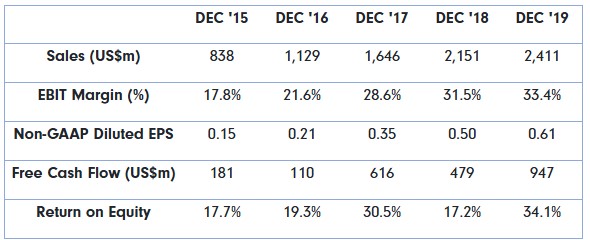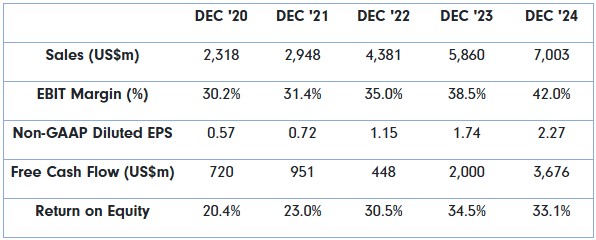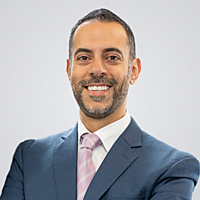Unveiling tomorrow's titans: A case study on Arista Networks
Arista Networks—a networking equipment company first captured our attention back in 2020. Demand for cloud computing and the ‘Internet of Things’ (IoT) devices was surging, fuelling an explosion of data volume and traffic.
At the time, we were on the hunt for high-quality small- to mid-cap global businesses with tremendous growth potential, to invest our new strategy, the Fidelity Global Future Leaders Fund.
This case study delves into the discovery and journey of Arista Networks. We will unpack our investment thesis, demonstrating our disciplined investment process and proprietary research advantage that helped capture the opportunity.
Showing potential
Founded in 2004, Arista Networks carved a niche for itself as a provider of high-end networking equipment, more specifically, multilayer network switches, crucial for data transfer within data centres and across locations.
We first invested in the company as one of our key holdings at the Fund’s inception in September 2020, when its share price was around US$13 (adjusted for subsequent stock splits). What drove our conviction?
A strong foundation in market and behind the desk
First, the industry itself was quite attractive. We could see that network switches stood to benefit from the explosion in data volume and traffic occurring at the time. The market structure for switches was also relatively attractive. When we looked at the market landscape at that time in 2019, the elephant in the room was Cisco, holding~35% of market share. Arista was next, with ~15%1 market share. After Arista, there were a handful of other notable players (though significantly fewer): Huawei (~10%)1, Hewlett Packard (~6%)1 and H3C (~4%)1, followed by a tail of others. Thus, the top two players owned half the market, and the top five combined owned around 70%. We viewed this positively. A structure with a few dominant players tends to be quite stable, with consistent supply and quality of products and services, but one which also drives innovation within the industry.
Furthermore, Arista was the market leader in their core market, hyperscale data centres. It came as no surprise their revenue was highly correlated to cloud capital expenditure (capex), with its largest two customers being Meta Platforms and Microsoft.
A large moat from its competitors
What differentiated Arista from Cisco is their software-first strategy used for their switches, meaning their switches were (and still are) designed to run on their own proprietary operating system. Think of Windows running your PC – their Enterprise Operating System runs the switches and keeps all devices updated and running on the latest version. This software capability gives Arista a technological edge over its peers and while it may not be the cheapest option, customers often prefer Arista’s higher quality product. This is a good example of their pricing power.
We saw Arista’s strong management team as another key strength. The company was founded in 2004 by Andy Bechtolsheim, Kenneth Duda and David Cheriton. Andy is probably the most notable figure in the company and a Silicon Valley legend. He co-founded Sun Microsystems in 1982, one of the most well-known tech companies of the dot com bubble - that was later acquired by Oracle in 2007.
After leaving Sun in 1995, Andy founded Granite Systems and hired Ken Duda as his first employee. Cisco acquired Granite in 1996, and Andy and Ken were absorbed into the Cisco ecosystem as part of the acquisition. Andy also co-founded Kealia with Stanford professor David Cheriton, acquired by Sun in 2004.
Brought together by successful launches and acquisitions, this impressive trio then collectively co-founded Arista Networks. If that pedigree isn’t enough to showcase the talent behind Arista, Andy and David were also the first private investors in Google. In 1998, they each wrote a US$100,000 cheque to Google founders Larry Page and Sergey Brin, before Google had even been legally incorporated. Now we all know how that investment played out.
Andy and Ken remain directly involved in Arista today. Andy was appointed as Chief Architect and Ken as Chief Technology Officer. In 2008, Jayshree Ulla joined from Cisco, and now serves as CEO. Today, Andy continues to own ~15% of Arista (valued at almost US$17b) while Jayshree owns close to 3% (worth ~US$3.5b). Ken Duda retains a US$300m position having sold down gradually over time. This shows their conviction in the long-term growth of the business as well as alignment of interests between the owners and the company.
Financial trajectory and growth prospects
When we looked at Arista first in 2019 and then before investing in 2020, we reviewed the company fundamentals.
Artista Networks Financials (2015 - 2019)

Arista had clearly demonstrated a strong track record over this period of healthy revenue and earnings growth, expanding margins, strong free cash flow generation and high returns on equity. The most attractive part of the analysis was that Arista showed a robust growth trajectory and was selling at a 22x Price/Earnings ratio. For a company of this calibre, it was quite appealing. We believed this was a small premium to pay on the P/E ratio for a substantially higher quality company relative to others in market.
The value of our proprietary research
Why was the market offering such a good opportunity? In late 2019, Meta (then known as Facebook) announced a delay in its cloud capex, causing the market to speculate that Facebook was looking to reduce supplies from Arista, or increase share in a white label product supply.
However, our proprietary research told us there were other forces at play. We met with Facebook and Arista in Silicon Valley in 2019, where our discussions with company representatives revealed that Facebook’s delay was merely due to a pause on their capex cycle, waiting for the next iteration of Intel’s 10nm Ice Lake processor to be released.
From our on-the ground conversations and research, we believed Arista was still well and truly embedded within the Facebook supply chain, and the market fears were largely unfounded. Therein lay the opportunity - to back our conviction in Arista as a key portfolio holding at the inception of the Fidelity Global Future Leaders Fund.
Since our first investment in 2020, Arista has exceeded our expectations. They’ve been able to maintain very attractive revenue growth rates (except for CY2020 which was impacted by COVID disruptions), expand margins, increase earnings and free cash flow, and sustain high returns on equity.
Artista Networks Financials (2020 - 2024)

With Microsoft and Meta as their largest customers, accounting for approximately 35% of sales, Arista continues to benefit from its strategic partnerships and increased cloud capex driven by rising AI demand.
Portfolio graduation
In February 2024, we exited our position in Arista at a very healthy share price of US$70 (adjusted for stock splits). With a market cap of almost US$90b, Arista was no longer considered a mid-cap company, putting it outside our investment mandate.
It was a bittersweet exit, as our investment thesis still held, but rewarding to see that for the four years Arista was in the Fund’s portfolio its share price appreciated over 5-fold, contributing to strong returns to our investors.
As the tech industry continues to evolve, Arista's story serves as a beacon for investors seeking to uncover tomorrow's titans. With its strong positioning, financial stability, and strategic partnerships, we saw Arista Networks as a business poised to lead the charge into the future, and we weren’t disappointed.

5 topics
1 stock mentioned
1 fund mentioned

